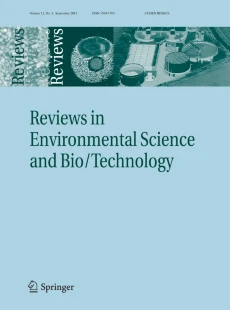Reviews in Environmental Science and Biotechnology
Comprehensive information about the Journal, including Impact factor, H-index, subject Area, Category, Scope, ISSN.

Journal Details
Overview
The areas of environmental science and environmental (bio)technology are broad, multidisciplinary, fast growing and extremely active. During the last few decades, an overwhelming amount of data has become available and a panoply of discoveries has been made. It is almost impossible to keep up to date on current developments in these areas. Moreover, there is a definite need to extract the quintessence out of this information, to synthesise the research progress and to identify the achieved advances in science and technology. This is the rationale behind the journal Reviews in Environmental Science and Bio/Technology. The journal has two distinct peer-reviewed sections: a section containing mini-reviews (up to 8 printed pages), expressing scientific opinions on topics and trends as well as a Reviews section (up to 30 printed pages) containing comprehensive critical evaluations of research efforts and technical realizations in particular areas. In addition to (mini-)review papers, the journal reports on newly initiated research projects in a distinct Project Update and Science Career section, focusing on initiatives from large research consortia and young researchers, respectively. The horizon paper, SWITCH monitor and Stockholm Water Perspectives sections provide research and policy-oriented commentaries from world renowned leaders in environmental science and (bio)technology research. The Web Alert section hints readers on key websites, whereas the Symposium Watch section updates them on the most recent developments in the field presented on international workshops, seminars and symposia. The journal also features special issues focusing on topics of international concern.
Impact Factor
The impact IF, also denoted as Journal Impact Score (JIS), of an academic journal is a measure of the yearly average number of citations to recent articles published in that journal. It is based on Scopus.
| Year | Impact Factor |
|---|---|
| No Impact Factor History Available | |
How Impact Factor is Calculated
The Impact Factor (IF) is a metric that reflects the yearly average number of citations to recent articles published in a journal.
Impact Factor = Total citations in the current year to articles published in the previous two years / Total number of articles published in the previous two years
This metric, provided by databases like Scopus and Clarivate Analytics, helps researchers identify influential journals in their field.
H-index
The H-index of this journal is110

What is H-index?
The H-index is a metric used to measure the productivity and citation impact of a researcher or journal. It is defined as the maximum value of h such that the entity has published h papers that have each been cited at least h times.
Formula: Identify the largest number h where at least h publications have received at least h citations.
The H-index provides a balanced measure of both the quantity (number of publications) and quality (citations) of the output.
SJR
The SJR value of this journal is2.507

What is SJR?
The Scimago Journal Rank (SJR) is a prestige metric that ranks journals based on their scientific influence and the quality of citations they receive. It is developed from the information in the Scopus database.
SJR is calculated based on the weighted citations received in a given year. The weights are determined by the prestige of the citing journal.
SJR takes into account both the number of citations and the importance of the citing journals, offering a balanced perspective on the scientific impact of a journal.
Citation & Publication Metrics
38
Total Documents (2023)
116
Total Docs (3 years)
1639
Total Cites (3 years)
8.86
Cites / Doc (2 years)
Quartile History
Subject Area & Category
Areas
Categories
Data Source
All ranking, citation, and classification data presented on this page is sourced from Scimago Journal & Country Rank.


























